Dr. B.R. Ambedkar: Answering the Questions You've Always Had
My humble tribute to him on the occasion of his Birth Anniversary
Today, April 14, marks the Birth Anniversary of Dr. B.R. Ambedkar, a towering figure in India's struggle for social justice and equality. As we commemorate his legacy, we must ask ourselves: how much do we really know about this visionary leader? What were his early years like, and how did he overcome immense social and economic barriers to become one of India's most renowned scholars, jurists, and politicians? How did he influence the Indian Constitution, and what was his role in shaping India's legal and political landscape? In this article, we will answer these questions and more, exploring the life, work, and enduring legacy of this remarkable man.
1. When and where was he born and tell us a little about his parents?
Dr. B.R. Ambedkar was born on April 14, 1891, in Mhow (now known as Dr. Ambedkar Nagar), in the central Indian state of Madhya Pradesh. At the time of his birth, Mhow was a cantonment town in the British Indian Army.
Dr. Ambedkar was born into a family belonging to the Mahar caste, which was considered one of the lowest castes in the Indian social hierarchy at that time. His father, Ramji Maloji Sakpal, was a Subedar (an officer) in the British Indian Army, and his mother's name was Bhimabai. Dr. Ambedkar's parents were very poor, and his family faced significant discrimination and social ostracization due to their low caste status. Despite these challenges, Dr. Ambedkar was a bright student and went on to achieve many academic and professional accomplishments in his lifetime.
2. A little bit about his siblings?
Dr. Ambedkar had four siblings. His eldest brother's name was Balaram, and his younger brothers were Anandrao and Bhimrao. His sister's name was Manjula.
Like Dr. Ambedkar, his siblings also faced discrimination and social exclusion due to their low caste status. However, they were supportive of Dr. Ambedkar's educational pursuits and encouraged him to pursue higher studies despite the significant obstacles he faced. Anandrao and Bhimrao also went on to earn college degrees, which was a significant achievement for members of their caste at the time.
3. His early years and school education?
Dr Ambedkar's early years were marked by poverty and discrimination due to his low-caste status. He faced many challenges in his education, including being barred from attending the local school because he was considered "untouchable" by higher-caste students and teachers.
Despite these challenges, Dr. Ambedkar was a very bright student and was eventually able to attend school thanks to the support of a Parsi teacher, who took an interest in his education and became his mentor. Dr. Ambedkar was able to complete his elementary education at the local school and went on to attend high school in Bombay (now Mumbai).
Dr. Ambedkar faced significant discrimination and harassment at his high school due to his low-caste status, but he was able to persevere and earn good grades. After completing high school, he went on to study at Elphinstone College in Bombay, where he earned a scholarship to study abroad in the United States.
4. His college and University education and more specifically the scholarships/ financial assistance that he won?
Dr. Ambedkar was an exceptional student, and he earned several scholarships and financial assistance throughout his academic career, which helped him pursue higher education despite his family's financial difficulties.
After completing his high school education, Dr. Ambedkar attended Elphinstone College in Bombay, where he earned a scholarship for outstanding performance in his first-year exams. He later received another scholarship to study at the University of Bombay, where he earned a degree in economics and political science in 1912.
In 1913, Dr. Ambedkar was awarded a scholarship by the Gaekwad of Baroda, a local ruler, to study at Columbia University in New York. At Columbia, he earned a master's degree in economics and a PhD in economics in 1927, becoming one of the first Indians to earn a doctorate degree from a foreign university.
During his time at Columbia, Dr. Ambedkar also earned scholarships from other sources, including the Maharaja of Kolhapur, the Maharaja of Baroda, and the Sir Dorabji Tata Trust. These scholarships and financial assistance helped him pursue his education and research without worrying about financial difficulties.
5. Any incident early on in his life that greatly influenced him and shaped his political thoughts and philosophy?
There was an incident early in Dr. Ambedkar's life that greatly influenced his political thoughts and philosophy. When he was a young boy, he was denied access to the local water source in his village because he was considered "untouchable" by higher-caste villagers. As a result, he had to rely on a kind schoolteacher who would bring water to him and other "untouchables" in his class.
This incident made a deep impression on Dr. Ambedkar, and he became acutely aware of the discrimination and injustice faced by people from lower castes. He later described this experience as a turning point in his life and credited it with shaping his lifelong commitment to fighting for the rights of the marginalized and oppressed.
Dr. Ambedkar's experiences of discrimination and prejudice also inspired his advocacy for the rights of the Dalit community and his belief in the need for social and political reform to address the systemic inequalities and injustices faced by marginalized communities in India.
6. When did he return to India and what did he start doing?
Dr. Ambedkar returned to India in 1924 after completing his studies in the United States. Upon his return, he was appointed as the professor of Political Economy at Sydenham College in Bombay.
In addition to his teaching responsibilities, Dr. Ambedkar also became increasingly involved in social and political activism, particularly in advocating for the rights of the Dalit community. He founded several organizations and movements aimed at promoting the interests of the Dalit community and fighting against caste-based discrimination and oppression.
In 1927, Dr. Ambedkar founded the Bahishkrit Hitakarini Sabha (Outcastes Welfare Association) to promote the social, educational, and economic rights of Dalits. He also founded the Scheduled Castes Federation in 1942, which aimed to bring together Dalit political groups and work towards political empowerment and representation for the community.
Throughout his career, Dr. Ambedkar remained committed to social and political reform and was a vocal advocate for the rights of marginalized communities in India.
7. How did he meet Mahatma Gandhi and what his personal and political relationship with him?
Dr. Ambedkar and Mahatma Gandhi met for the first time in 1919, when Dr. Ambedkar was leading a delegation of Dalit activists seeking to represent their grievances to the British authorities. Gandhi was at the time leading a non-cooperation movement against the British government and was not receptive to Dr. Ambedkar's demands for separate electorates for Dalits.
Their paths crossed again in the 1930s, when Gandhi launched the Harijan (meaning "children of God," a term he used to refer to Dalits) movement to improve the social and economic conditions of the Dalit community. Dr. Ambedkar was initially skeptical of Gandhi's approach, which focused on uplifting the Dalits within the existing caste system, and argued instead for the abolition of the caste system altogether.
Despite their differences, Gandhi and Dr. Ambedkar had several interactions and discussions over the years, and their relationship evolved over time. In 1932, they reached the Poona Pact, which provided for reserved seats for Dalits within the general electorate rather than separate electorates. The agreement was a compromise on both sides, with Dr. Ambedkar conceding to Gandhi's position in exchange for greater representation for Dalits in the political process.
Their personal relationship was marked by mutual respect and occasional disagreements. Dr. Ambedkar admired Gandhi's commitment to non-violent resistance and his moral authority, but also criticized his views on caste and his approach to social and political reform. Gandhi, in turn, respected Dr. Ambedkar's intellectual prowess and his unwavering commitment to social justice but sometimes accused him of being too confrontational and not working within the system to bring about change.
8. How did he meet Pandit Jawahar Lal Nehru and what his personal and political relationship with him?
Dr. Ambedkar first met Pandit Jawaharlal Nehru in 1937, when the Indian National Congress won elections in several provinces and formed provincial governments. Dr. Ambedkar was appointed as the Labour Minister in the government of Bombay and Nehru was the Congress leader in the Central Legislative Assembly.
Their political relationship was cordial, and Nehru expressed support for some of Dr. Ambedkar's efforts to improve the status of Dalits. For example, Nehru supported the inclusion of provisions for affirmative action for Dalits in the Indian Constitution, which Dr. Ambedkar was instrumental in drafting.
However, their personal relationship was not as close as Dr. Ambedkar's relationship with Gandhi. Nehru was seen as representing the upper-caste, English-educated elite, while Dr. Ambedkar was seen as the leader of the Dalit community. In addition, they had different visions for the future of India, with Nehru advocating for a socialist, secular, and democratic state, while Dr. Ambedkar emphasized the need for strong protections for Dalits and other marginalized communities.
Despite these differences, Nehru recognized Dr. Ambedkar's contributions to the Indian Constitution and his advocacy for the rights of Dalits, and appointed him as India's first Law Minister in the newly independent government in 1947. However, their political differences continued, and Dr. Ambedkar resigned from the government in 1951, citing differences over land reform and other issues.
9. What was his role in the Quit India Movement?
Dr. Ambedkar did not play a significant role in the Quit India Movement, which was launched by Mahatma Gandhi in 1942 as a mass civil disobedience campaign to demand the immediate withdrawal of British rule from India.
Dr. Ambedkar had his own political agenda and focus, which was on advocating for the rights of Dalits and marginalized communities. He believed that the Dalit community's interests would not be served by participating in mass movements and that they needed to have their own political voice and representation.
However, Dr. Ambedkar did support the Indian independence movement and was a member of the Viceroy's Executive Council from 1942 to 1946, where he advocated for greater representation for Dalits in government and the public sphere. He also played a key role in drafting the Indian Constitution, which was adopted in 1950 after India gained independence, and which provided for reservations in education and government jobs for Scheduled Castes (Dalits) and Scheduled Tribes.
10. How was he elected to the Constituent Assembly? Or, was he nominated?
Dr. Ambedkar was not elected to the Constituent Assembly but was nominated as a member by the Governor-General of India in consultation with the Indian National Congress. His nomination was based on his expertise in law and his leadership within the Dalit community.
Dr. Ambedkar's appointment to the Constituent Assembly was significant because it gave him a platform to advocate for the rights of Dalits and to shape the future of the Indian Constitution. He served on several committees and played a key role in drafting the Constitution, including its provisions for affirmative action for Dalits and other marginalized communities.
His nomination to the Constituent Assembly was also a recognition of his growing stature as a leader within the Indian political landscape, and of the importance of Dalit representation in the process of drafting India's constitution.
11. Did he mentor any Dalit leaders? Who inherited his political legacy?
Dr. Ambedkar did mentor several Dalit leaders during his lifetime, including Kanshi Ram and Ram Vilas Paswan. Kanshi Ram founded the Bahujan Samaj Party (BSP), which is a political party that represents the interests of Dalits, as well as other marginalized groups in India. Ram Vilas Paswan founded the Lok Janshakti Party (LJP), which also represents the interests of Dalits and other marginalized groups.
In terms of inheriting his political legacy, several political parties and movements have emerged in India that are based on Dr. Ambedkar's ideas and philosophy. These include the Republican Party of India (RPI), which was founded in 1957 by Dr. Ambedkar's followers, and the Dalit Panthers, which was a militant Dalit organization that was active in Maharashtra in the 1970s.
12. How did he become the Chairman of the Drafting Committee of the Constitution in the Constituent Assembly?
Dr. Ambedkar was appointed as the Chairman of the Drafting Committee of the Constituent Assembly by the President of the Assembly, Dr. Rajendra Prasad, on 29th August 1947. The Drafting Committee was responsible for preparing the draft of the Indian Constitution, which would serve as the guiding document for the newly independent India.
Dr. Ambedkar's appointment as the Chairman of the Drafting Committee was based on his expertise in law, his knowledge of the Indian Constitution, and his leadership within the Dalit community. He had also previously served as a member of the Constituent Assembly, and his contributions to the debates and discussions within the Assembly had been widely recognized and respected.
Dr. Ambedkar's appointment as the Chairman of the Drafting Committee was a significant moment in the history of India because it gave him the opportunity to shape the future of the country and to advocate for the rights of marginalized communities. He played a key role in drafting the Constitution, including its provisions for affirmative action for Dalits and other marginalized communities, which continue to be a cornerstone of India's democracy today.
13. What are his most influential books or pamphlets?
Dr. B.R. Ambedkar was a prolific writer and authored several influential books and pamphlets. Some of his most significant works are:
"Annihilation of Caste": This is a seminal work in which Dr. Ambedkar challenges the caste system and argues that caste is a social evil that needs to be abolished.
"The Buddha and His Dhamma": This book examines the teachings of the Buddha and their relevance to modern times. It also explores the role of Buddhism in shaping Indian society.
"Who Were the Shudras?": In this book, Dr. Ambedkar traces the origins of the Shudra caste and argues that they were originally a part of the Kshatriya caste.
"Pakistan or The Partition of India": This is a political pamphlet in which Dr. Ambedkar argues that the partition of India is necessary to safeguard the rights of the Dalits and other marginalized communities.
"The Untouchables: Who Were They and Why They Became Untouchables": In this book, Dr. Ambedkar traces the history of the Dalit community and examines the social, economic, and political factors that led to their marginalization and exclusion from mainstream society.
These works have had a profound impact on Indian society and continue to be relevant today. Dr. Ambedkar's ideas and philosophy continue to inspire movements for social justice and equality in India and around the world.
14. Is there any incident when he was disinvited for a major event where he was to speak on his book about annihilation of caste?
Yes, there is an incident when Dr. B.R. Ambedkar was disinvited from a major event where he was to speak on his book "Annihilation of Caste."
In 1936, the Jat-Pat-Todak Mandal, a social reform organization in Lahore, had invited Dr. Ambedkar to deliver a speech on his book "Annihilation of Caste." However, shortly before the event, the organizers withdrew the invitation, fearing that Dr. Ambedkar's speech might offend the Hindu community and create social unrest.
Dr. Ambedkar responded to the disinvitation by publishing his speech as a book, which became one of his most influential works. In the book, he criticized the Hindu caste system and called for its complete abolition, arguing that it was responsible for perpetuating social inequality and injustice.
The incident is considered a turning point in Dr. Ambedkar's life and career, as it reinforced his commitment to social justice and inspired him to continue his fight for the rights of Dalits and other marginalized communities.
15. What were the major features of the Indian Constitution that he is credited with?
Dr. B.R. Ambedkar played a crucial role in drafting the Indian Constitution and is credited with several of its major features. Here are some of the key features that he is associated with:
Fundamental Rights: The Indian Constitution guarantees several fundamental rights to its citizens, including the right to equality, freedom of speech and expression, and the right to life and liberty. Dr. Ambedkar played a key role in drafting these provisions, which were designed to ensure that all citizens of India are treated equally and with dignity.
Directive Principles of State Policy: The Constitution also includes Directive Principles of State Policy, which lay down the framework for social and economic justice in India. Dr. Ambedkar believed that these principles were essential to building a just and equitable society.
Reservation Policy: Dr. Ambedkar is also credited with the reservation policy in India, which provides affirmative action for Dalits and other marginalized communities in education and employment. He believed that reservation was necessary to redress historical injustices and to promote social equality.
Federal Structure: The Indian Constitution provides for a federal structure, which divides power between the central government and the states. Dr. Ambedkar played a key role in designing this structure, which was intended to ensure that power was distributed fairly and that the rights of the states were protected.
Independent Judiciary: Dr. Ambedkar was a strong advocate for an independent judiciary, which is enshrined in the Indian Constitution. He believed that an independent judiciary was necessary to protect the rights of citizens and to ensure that the government was accountable to the people.
These features have had a profound impact on Indian democracy and continue to shape the country's political and social landscape.
16. What were some of the features that he failed to get incorporated in the Indian Constitution?
Dr. B.R. Ambedkar played a significant role in the drafting of the Indian Constitution and was instrumental in including several key provisions. However, there were also some features that he advocated for but were not ultimately incorporated into the Constitution. Here are some examples:
Uniform Civil Code: Dr. Ambedkar was a strong proponent of a Uniform Civil Code that would apply to all citizens of India regardless of religion. However, this provision was not included in the Constitution due to opposition from some religious groups.
Women's Rights: Dr. Ambedkar was a champion of women's rights and advocated for provisions that would ensure gender equality in all spheres of life. However, the Constitution does not include all the provisions that he had envisioned, such as equal pay for equal work.
Abolition of Capital Punishment: Dr. Ambedkar was opposed to the death penalty and argued that it had no place in a civilized society. However, capital punishment is still legal in India, and efforts to abolish it have not been successful so far.
Language Policy: Dr. Ambedkar had advocated for the adoption of Hindi as the sole official language of India. However, this proposal faced opposition from non-Hindi speaking regions, and the Constitution ultimately recognized several official languages.
While these features were not included in the Constitution, they remain important issues in Indian society and continue to be debated and discussed. Dr. Ambedkar's advocacy for these issues has had a lasting impact on Indian politics and society.
17. Did he contest the first general elections to the Lok Sabha in 1952?
Yes, Dr. B.R. Ambedkar contested the first general elections to the Lok Sabha in 1952. He was a candidate from the Bombay (North Central) constituency and contested as an independent candidate. However, he lost the election to his Congress party rival. Despite his loss, Dr. Ambedkar continued to play an active role in politics and continued to advocate for the rights of Dalits and other marginalized communities until his death in 1956.
18. Was he included in the first Cabinet of Pandit Nehru? If so, how, as he had lost the Lok Sabha election?
No, Dr. B.R. Ambedkar was not included in the first Cabinet of Pandit Jawaharlal Nehru, after the first General Election in 1952. As he had lost the Lok Sabha election in 1952, he was not a member of Parliament and was therefore not eligible to become a minister. However, he was appointed as a member of the Rajya Sabha (the upper house of the Indian Parliament) in March 1952 and served in this position until his death on 6 December 1956. During this period, he continued to participate in parliamentary debates and advocated for the rights of marginalized communities, particularly Dalits.
19. Did he resign from any Cabinet of Pandit Nehru? If so, when and why?
Dr. B.R. Ambedkar was never a part of the Cabinet under Pandit Jawaharlal Nehru, following the 1952 General Elections. However, he did serve as the first Law Minister of independent India from 1947 to 1951, during Nehru's tenure as the Prime Minister.
Dr. B.R. Ambedkar was sworn in as the first Law Minister of India on August 15, 1947, the same day that India gained its independence from British colonial rule. He resigned from his position on October 10, 1951, due to differences with the then Prime Minister Jawaharlal Nehru on the Hindu Code Bill.
After his resignation, Dr. Ambedkar continued to play an active role in politics and worked to build a coalition of Dalit and other marginalized groups. He founded the Republican Party of India in 1956, which became an important political force in the decades to come.
20. How did he come under the influence of Buddhism and when did he formally convert?
Dr. B.R. Ambedkar was born a Hindu and remained a Hindu for much of his life. However, he became increasingly critical of Hinduism as he grew older and began to advocate for the rights of Dalits and other oppressed communities in India.
In the late 1940s, Dr. Ambedkar began to study Buddhism and was deeply impressed by its emphasis on equality, social justice, and the rejection of caste-based discrimination. He saw Buddhism as a way to free Dalits from the constraints of Hinduism and the caste system, which he felt perpetuated their social and economic inequality.
On October 14, 1956, Dr. Ambedkar formally converted to Buddhism along with thousands of his followers in a ceremony in Nagpur, Maharashtra. He saw his conversion as a way to reject the Hindu caste system and to promote the principles of social justice and equality that he believed were central to Buddhism.
21. Is it a fact that he actively considering becoming a Sikh and almost did when he visited the Golden Temple, Amritsar?
Yes, it is a fact that Dr. B.R. Ambedkar considered converting to Sikhism at one point in his life. In 1953, he visited the Golden Temple in Amritsar and was deeply impressed by the Sikh religion's emphasis on social equality and community service. He even went so far as to prepare a statement announcing his intention to convert to Sikhism.
However, he ultimately decided not to go through with the conversion, citing concerns about the impact it might have on his political career and his commitment to the principles of Buddhism. Instead, he continued to promote the rights of Dalits and other marginalized communities through his work as a politician, social reformer, and advocate for social justice.
22. When and where did he die and what is his legacy in India today?
Dr. B.R. Ambedkar passed away on December 6, 1956, at his home in Delhi. He was 65 years old at the time of his death.
Dr. Ambedkar's legacy in India is immense. He is remembered as a social reformer, jurist, politician, and the chief architect of the Indian Constitution. He played a pivotal role in promoting the rights of Dalits and other marginalized communities and worked tirelessly to eradicate caste-based discrimination and promote social justice.
His ideas and teachings continue to inspire people in India and around the world today. He is remembered for his contributions to the fields of law, economics, sociology, and political science, as well as his advocacy for the rights of women and other marginalized groups. His vision of a more just and equal society continues to guide the work of social reformers, activists, and policymakers in India and beyond. Dr. Ambedkar's birth anniversary, April 14, is celebrated as a national holiday in India, known as "Ambedkar Jayanti."
In conclusion: As we reflect on Dr. Ambedkar's life and legacy, it is important to recognize that his vision of a just and equitable society continues to guide and inspire India today. The current government, led by Prime Minister Narendra Modi, has pledged to build a 'New India' that is inclusive, prosperous, and sustainable, and has recognized the critical role that Dr. Ambedkar's philosophy and ideals play in achieving this vision. By continuing to work towards the realization of his vision, we can create a society where every individual, regardless of their caste, creed, or gender, has the opportunity to lead a life of dignity and fulfillment. Dr. Ambedkar's life reminds us that even in the face of immense adversity, it is possible to strive for a better tomorrow, and that the future of India is in our hands.
____________________________________________________________________________
DISCLAIMER: I am NOT a qualified historian and this article is based on my own internet research. If there are any factual errors, please do point out in the comments on the “Substack App/ Website” and I shall be happy to correct. For my errors and omissions I apologise in advance. The copyright of all the photos is duly acknowledged.
REQUEST: If you think anyone you know or any of your groups would find this article useful, please do share.




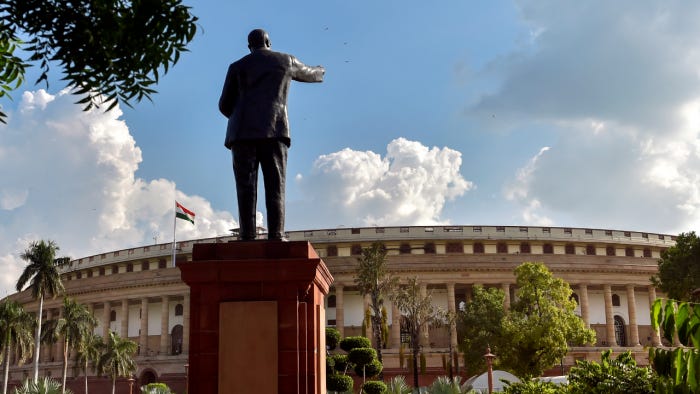
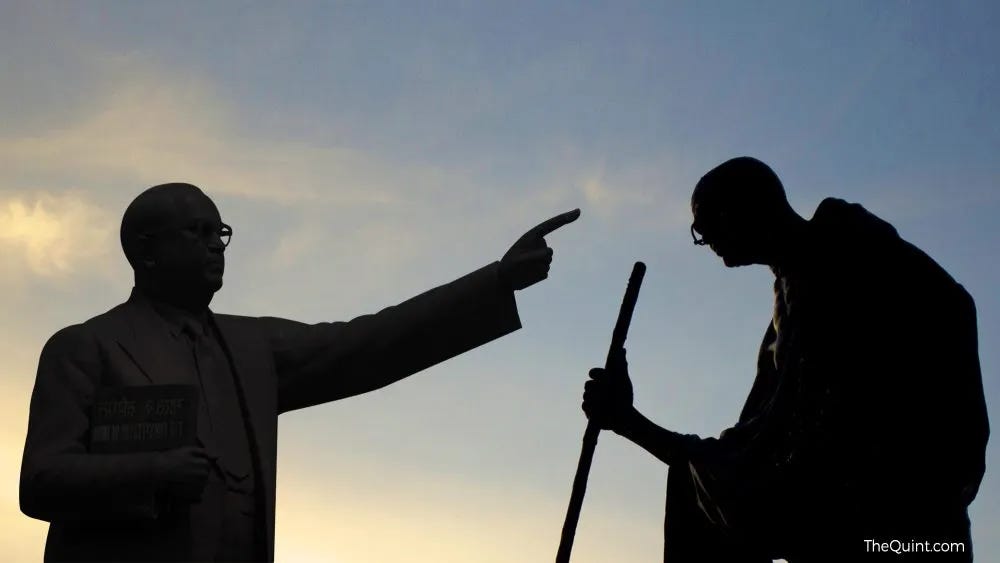
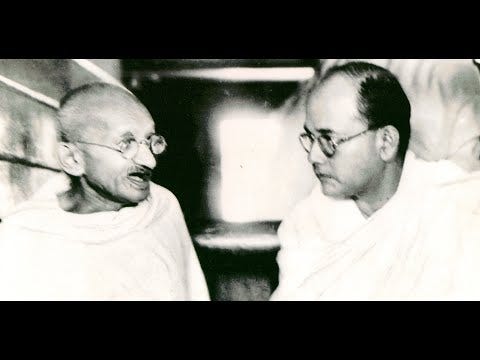
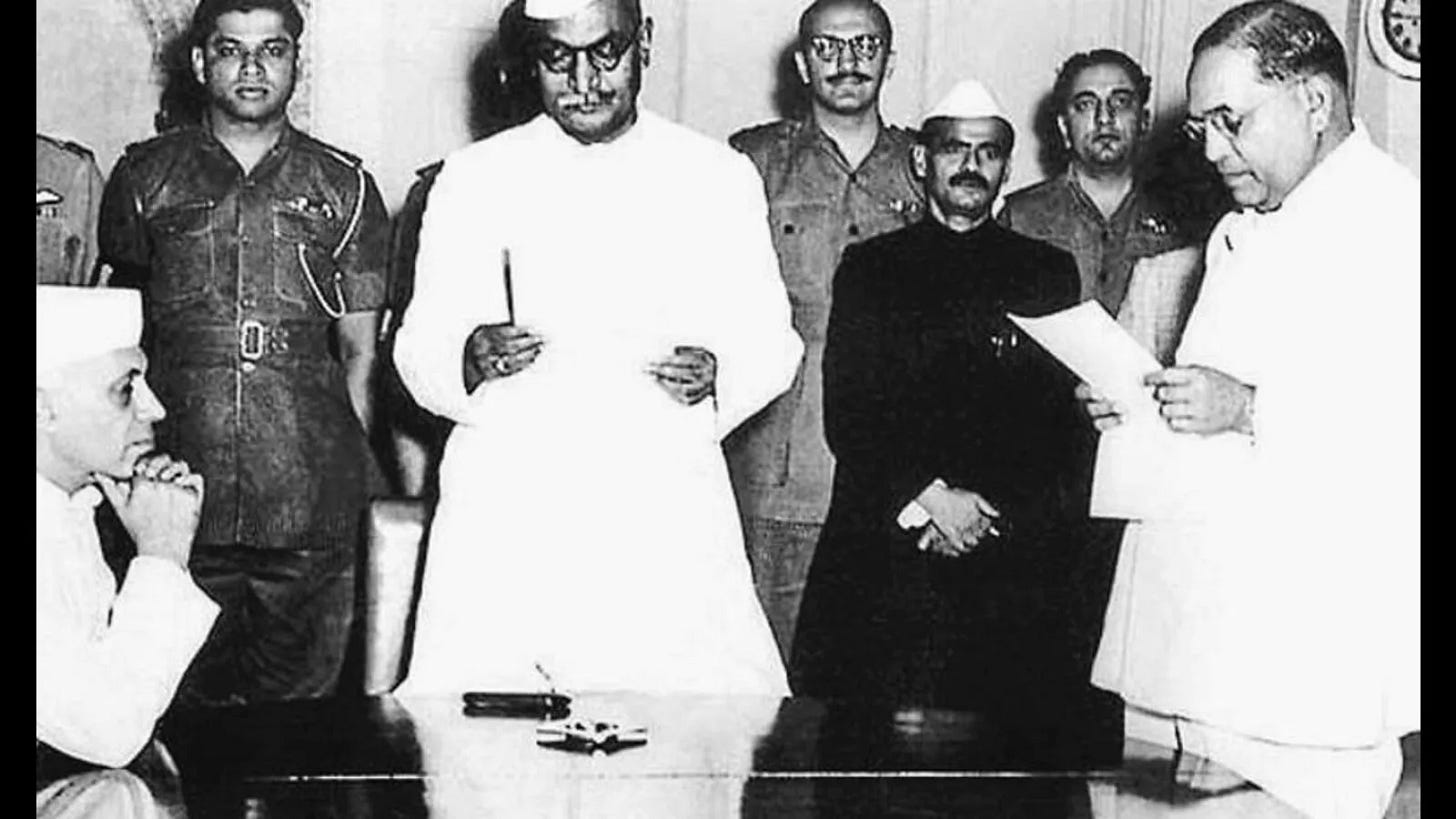
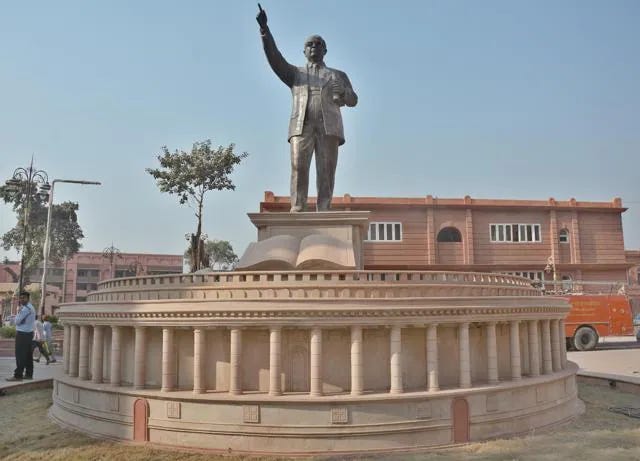
Great article covering lives and times of Dr B R Ambedkar
His legend has only grown with time.From peripheral political relevance he and his ideology has become central to any discussion on social justice in India.
Today no political party can even begin to think to contest his legacy
He will continue to be respected across the political spectrum and it is not beyond realm of imagination that one day he may become as relevant if not more than the father of the nation in our national discourse 💐👍
Our retired colleague Shri Roshan Lal Kalsia. ex-IAS sent me the following comments on WhatsApp, with the remarks that I may post them on the App. ⬇️⬇️⬇️
“A great tribute 👏.
“Dr Ambedkar is a person having the highest wisdom in the world 🌎.
“His writings have been beautifully published in 17 volumes by the Government of Maharashtra .
“His legacy as a great social reformer as well as the distinguished thinker in unparalleled.
“His passion for empowerment of women is extraordinary.
“His religion is about the equality, liberty and universal brotherhood.
“His Contribution to the Indian Constitution is exceedingly outstanding 👏.
“A matchless personality !
Indeed suitable words are missing to give him the right tribute.
“ Sir, thanks a lot to you for having presented 🎁 a scholarly narrative for the lovers of Dr. AMBEDKAR.”--RL Kalsia, IAS (retd.)